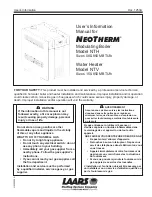
OPERATION
Lifting
WARNING: Only attachments and/or adapters supplied by the manufacturer shall be used. Lift only on area
of the vehicle as specified by the vehicle manufacturer.
NOTICE: These jacks are equipped with handle position locks. To adjust the handle, release lock device by pulling
the lever up, then back until lever is locked into place.
1. Follow the vehicle manufacturer’s recommended guidelines for lifting. Engage the emergency brake and chock
each unlifted wheel in both directions to prevent inadvertent vehicle movement.
2. Locate and close the release valve by turning the release valve knob clockwise until firm resistance is felt.
3. Refer to the vehicle manufacturer owner’s manual to locate approved lifting points on the vehicle. Center jack
saddle under lift point.
4. Verify lift point, then pump handle or foot pedal to contact lift point. To lift, pump handle or squeeze lift control
valve (Models 21032, 22041C, 22051C & 22101C) until load reaches desired height.
Never
use foot pedal to
raise load.
WARNING: Do not wire, clamp or otherwise disable the lift control valve to function by other than operator's
hand.
5. Transfer the load to appropriately rated jack stands.
Lowering
WARNING: Clear all tools and personnel before lowering load. Open the release valve slowly. The further the
release valve knob is turned counter-clockwise, the faster the load will descend. Maintain control of the load
at all times.
1. Raise load high enough to clear the jack stands.
2. Remove jack stands.
3. Turn the release valve knob counter-clockwise, but no more than 1/2 full turn.
If the load fails to lower:
a. Use another jack to raise the vehicle high enough to reinstall jack stands.
b. Remove the malfunctioning jack and then the jack stands.
c. Use the functioning jack to lower the vehicle.
4. Remove jack from under vehicle and fully lower the saddle to reduce ram exposure to rust and contamination.
MAINTENANCE
NOTICE:
Use good quality hydraulic jack oil. Avoid mixing different types of fluid and Never use brake fluid, turbine
oil, transmission fluid, motor oil or glycerin. Improper fluid can cause failure of the jack and the potential for sudden
and immediate loss of load. Premium quality hydraulic jack oil is recommended.
Adding oil
1. With saddle fully lowered set jack in its upright, level position. Locate and remove oil filler plug/screw.
2. Fill with oil until ~3/16" above the inner cylinder as seen from the oil filler hole. Reinstall the oil filler plug/screw.
Changing oil
For best performance, completely replace fluid supply at least once per year.
1. With saddle fully lowered, remove the oil filler plug/screw.
2. Lay the jack on its side and drain the fluid into a suitable container.
NOTICE: Dispose of hydraulic fluid in accordance with local environmental regulations.
3. Fill with oil until ~3/16" above the inner cylinder as seen from the oil filler hole. Reinstall the oil filler plug/screw.
4
!
!
!





































